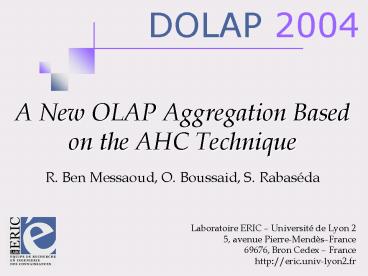A New OLAP Aggregation Based on the AHC Technique - PowerPoint PPT Presentation
1 / 20
Title:
A New OLAP Aggregation Based on the AHC Technique
Description:
DOLAP 2004 A New OLAP Aggregation Based on the AHC Technique R. Ben Messaoud, O. Boussaid, S. Rabas da Laboratoire ERIC Universit de Lyon 2 – PowerPoint PPT presentation
Number of Views:107
Avg rating:3.0/5.0
Title: A New OLAP Aggregation Based on the AHC Technique
1
DOLAP 2004
A New OLAP Aggregation Based on the AHC Technique
R. Ben Messaoud, O. Boussaid, S. Rabaséda
Laboratoire ERIC Université de Lyon 2 5, avenue
Pierre-MendèsFrance 69676, Bron Cedex
France http//eric.univ-lyon2.fr
2
Complex data
- Definition
- Data are considered complex if they are
- Multi-formats information can be supported by
different kind of data (numeric, symbolic, texts,
images, sounds, videos ) - Multi-structures structured, unstructured or
semi-structured (relational databases, XML
documents ) - Multi-sources data come from different sources
(distributed databases, web ) - Multi-modals the same information can be
described differently (data in different
languages ) - Multi-versions data are updated through time
(temporal databases, periodical inventory )
3
General context
- Complex data
- Huge volumes of complex data
- Warehousing complex data
- OLAP facts as complex objects
- Analyze complex data
- Current OLAP tools arent suited to process
complex data - Data mining is able to process complex data like
images, texts, videos - Coupling OLAP and data mining
- Analyze complex data on-line
- New operator OpAC Operator of Aggregation by
Clustering (AHC)
4
Outline
0
- Complex data and general context
- Related work Coupling OLAP and data mining
- Objectives of the proposed operator
- Formalization of the operator
- Implementation and demonstration
- Conclusion and future works
1
2
3
4
5
5
Related work
- Three approaches for coupling OLAP and data
mining - First approach Extending the query languages of
decision support systems - Second approach Adapting multidimensional
environment to classical data mining techniques - Third approach Adapting data mining methods for
multidimensional data
6
Related work
- These works proved that
- Associating data mining to OLAP is a promising
way to involve rich analysis tasks - Data mining is able to extend the analysis power
of OLAP
- Use data mining to enhance OLAP tools in order to
process complex data - OpAC A new OLAP operator based on a data mining
technique
7
Objectives
- Classic OLAP aggregation Vs OpAC aggregation
- Classic OLAP
- Summarizes numerical data in a fewer number of
values - Computes additive measures (Sum, Average, Max,
Min )
Example Sales cube
8
Objectives
- Classic OLAP aggregation Vs OpAC aggregation
- OpAC aggregation
- What about aggregating complex objects?
- How to aggregate images, texts or videos with
classic OLAP tools? - Complex objects are not additive OLAP measures
Example Images cube
?
9
Objectives
- How to aggregate complex objects?
- Using a data mining technique AHC (Agglomerative
Hierarchical Clustering) - The AHC aggregates data
- The hierarchical aspect of the AHC
10
Objectives
Images
Very high High Medium Low Very low
Very high High Medium Low Very low
Entropy
Homogeneity
11
Formalization
- Di the ith dimension of a data cube C
- hij the jth hirarchical level of the
dimension Di - gijt the tth modality of hij
- The set of individuals
W Ì gijt / gijt Î hij
- The set of variables
- Dimension retained for individuals cant generate
variables - Only one hierarchical level of a dimension is
allowed to generate variables
12
Formalization
- Evaluation tools
- Minimize the intra-cluster distances
- Maximize the inter-cluster distances
- Inter and intra-cluster inertia
- A1 , A2 , , Ak is a partition of W
- P(Ai) is the weight of Ai
- G(Ai) is the gravity center of Ai
13
Formalization
- Individuals
- Modalities from the dimension of images
- Variables
- L1Normalized values of images for all possible
modalities of the entropy dimension - L1Normalized values of images for all possible
modalities of the homogeneity dimension
14
Formalization
- Results
- Exploits the cubes facts describing images to
construct groups of similar complex objects - Highlights significant groups of objects by a
clustering technique - Clusters aggregates- are defined both from
dimensions and measures of a data cube - Implementation of a prototype
15
Implementation
- Prototype
- Data loading module
- Connects to a data cube on Analysis Services of
MS SQL Server - Uses MDX queries to import information about the
cubes structure - Extract data selected by the user
- Parameter setting interface
- Assists the user to extract individuals and
variables from the cube - Selects modalities and measures
- Defines the clustering problem
- Clustering module
- Allows the definition of the clustering
parameters like dissimilarity metric and
aggregation criterion - Constructs the AHC
- Plots the results of the AHC on a dendrogram
16
Implementation
- Images dataset
- 3000 images collected from the web
- Semantic annotation Description, subject and
theme - Descriptors of texture like
- ENT Entropy
- CON Contrast
- L1Normalized Medium Color Characteristic
- Three color channels RGB
17
Implementation
Demonstration
18
Conclusion
- OpAC is a possible way to realize on-line
analysis over complex data - OpAC aggregates complex objects
- Aggregates clusters- are defined from both
dimensions and measures of a data cube - Prototype available at
- http//bdd.univ-lyon2.fr/?pagelogicielid5
19
Future works
- The current evaluation tool may present some
limits - Use other evaluation indicators to evaluate the
quality of partitions - Assist user to find the best number of clusters
- Exploit the aggregates generated by OpAC in order
to reorganize the cubes dimensions - Get a new cube with remarkable regions
- Use other data mining technique to enhance the
OLAP power with explanation and prediction
capabilities
20
The End






























